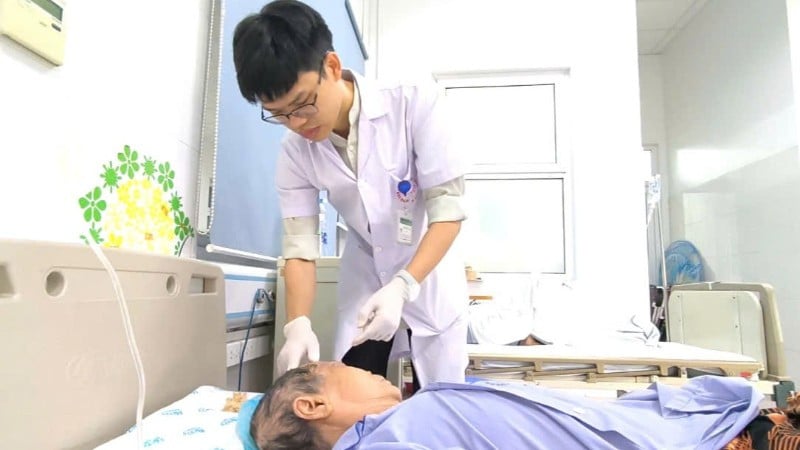
The Central Hospital for Tropical Diseases has just admitted and treated Ms. NTQ (78 years old, residing in Bac Ninh). She was hospitalized with severe cellulitis on her face, forehead and top of her head caused by Staphylococcus aureus. The affected areas were red, swollen, oozing pus and accompanied by sepsis.
The patient had a history of bronchial asthma and had regularly used corticosteroids for a long time without a doctor's prescription. Two years ago, she had a stroke that left her left side paralyzed and was being treated for high blood pressure but the type of medication was unknown.
According to her family, about 20 days before being admitted to the hospital, Ms. Q. had clusters of blisters on her face and top of her head. She had been treated for 7 days at a lower-level hospital, but her condition did not improve, the lesions spread, she was severely swollen and oozing pus. Therefore, she was transferred to the Central Hospital for Tropical Diseases.
Specialist II Doctor Nguyen Hong Long - Deputy Head of the Department of General Infections said that the patient was hospitalized in a state of severe infection after being infected. Herpes zoster. Due to not being detected and treated promptly, the disease led to widespread cellulitis in the face and scalp. The CT scan of the brain also suspected osteomyelitis.
After 7 days of intensive treatment, her infection was under control. However, the scalp was extensively necrotic, so doctors were forced to perform surgery to remove necrotic tissue and install a negative pressure suction system (VAC) to clean the wound.
According to Master, Doctor Nguyen Ngoc Linh - a specialist in Aesthetic Plastic Surgery, herpes zoster in the hairy scalp is a rare disease. In this case, the patient was elderly and had a weakened immune system due to prolonged use of corticosteroids, causing widespread and severe damage. Staphylococcus aureus bacteria penetrated deep into the subcutaneous tissue, causing necrosis of the entire Galea fascia (a layer of tendons under the scalp) and the fat layer of the head.
The damaged scalp area was about 7x10cm in size, while the necrotic fat fascia area extended to nearly half the circumference of the head, accompanied by a lot of pus and pseudomembrane. This was a very complicated case of Staphylococcus aureus infection of the head, with a large degree of necrosis and the risk of inflammation spreading to the skull bone, even to the brain parenchyma if not treated promptly.
The patient then underwent surgery to completely debride the necrotic tissue and place a negative pressure suction system called VAC. This system helps remove dirty fluid, necrotic tissue, bacteria, clean the inflammation site and stimulate the formation of new granulation tissue.
After 1-2 weeks of treatment with the VAC system, when the inflammation is controlled, the doctors will proceed to shape the damaged scalp to restore the damage.
According to Dr. Linh, the main reason for the patient's severe necrosis was due to late treatment of shingles, combined with a weakened immune system due to prolonged use of corticosteroids. This created favorable conditions for bacteria to invade and cause dangerous complications.
Fortunately, after intensive treatment, the patient's infection was controlled and the lesions on the scalp are recovering well.
Specialist Doctor II Nguyen Nguyen Huyen - Director of the Center for Disease Control, Central Hospital for Tropical Diseases recommends: People aged 50 and over, especially those with underlying diseases or weakened immune systems, should proactively get vaccinated against shingles. This vaccine helps reduce the risk of getting the disease and eases the severity of symptoms if they are unfortunately infected. This is an effective measure to help the elderly protect their health and improve their quality of life.
When initial signs such as burning pain, rash or blisters on the skin appear, the patient should see a doctor early for timely diagnosis and treatment. This helps avoid the risk of serious complications such as necrosis, sepsis or prolonged nerve damage.
Source: https://nhandan.vn/cu-ba-hoai-tu-da-dau-do-bien-chung-nguy-hiem-cua-zona-post893850.html






































































































Comment (0)